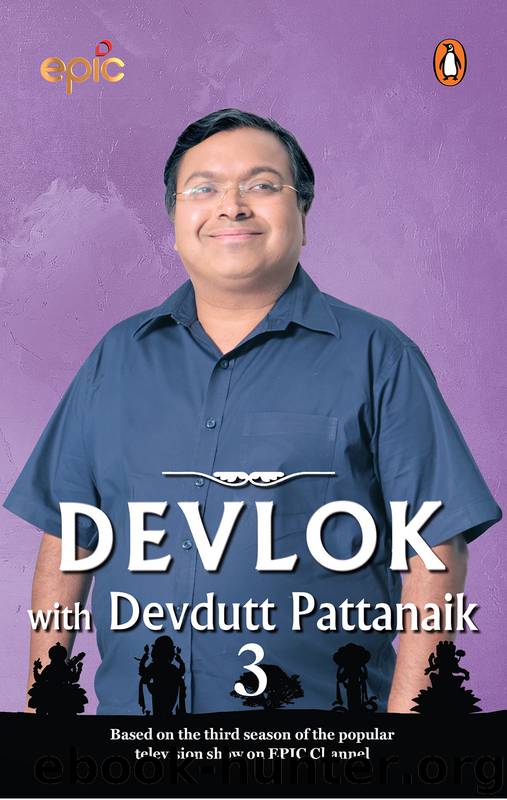Devlok with Devdutt Pattanaik 3 by Devdutt Pattanaik

Author:Devdutt Pattanaik
Language: eng
Format: epub
ISBN: 9789353050238
Publisher: Penguin Random House India Private Limited
Published: 2018-04-18T16:00:00+00:00
11
Dravida
The Mahabharata is based in Hastinapur and Indraprastha in north India. Rama goes from Ayodhya to Lanka—from the north to the south. Are there any stories that originate in the south?
Yes. When the Ramayana and the Mahabharata were being created in north India, many mahakavyas were being written in the Tamil language. There used to be Sangams (meetings of poets) as far back as 3000 years ago in Madurai, Kanchipuram and so on. Sages and monks would also attend them. There was a rich tradition, a focus on literature, called Sangam parampara. The poems of this time are of two kinds: one is Puram, or poems of the city, and the other is Akam, which talk about emotions. Basically outer and inner traditions. This is also there in the Vedic tradition which had aranya gaan (forest songs) and gram gaan (city songs).
The outer traditions were all about veer rasa, about kings and warriors going to war on elephants and so on. The inner traditions, private conversations, have stories of romance, shringara bhav, women, love and separation. There is a lot of sensuality and energy. There are strong women who play an important role in this tradition. We see gramadevis and devatas being depicted here, and we get a glimpse of the Vedic period. Yagna is spoken of, but in the background. The Buddhist and Jain traditions too are present here. But at the centre are stories of kings and queens, ganikas (courtesans), soldiers, merchants and their wives. The Ramayana and the Mahabharata are more about kings and queens. Here, there are stories of the merchant class who had shipping businesses, which was a big tradition in south India. Merchants would sail to South East Asia, Egypt and Rome to sell cloth and masalas. They were never spoken about in the poetry of the north. The wealthy merchant class—today’s Chettiyars who have a long history—was present in south Indian poetry.
There were four main mahakavyas, great epics, from the third to fourth centuries that are worthy of mention. One was Silappatikaram, the story of Kannagi, a merchant’s daughter. Second was Manimekalai, the story of the daughter of a ganika. Third was Civaka Cintamani, the story of a warrior, and the fourth was Kundalakesi, the story of a businessman’s daughter. Three out of these four have female central characters.
Tell us the story of Silappatikaram.
Silappatikaram is about a rich merchant’s daughter, Kannagi, who marries another merchant’s son, Kovalan, in a place called Poompuhar. The boy falls in love with a dancer called Madhavi and blows up all his money on her. In those days, men keeping mistresses was common, but this boy is so carried away that he loses his fortune. One night, Kannagi and Kovalan have an argument about him drinking and wasting money. Kannagi is so upset that she takes off her bangles, which were his anniversary gift to her, and tells him to leave the house and never come back. Kovalan comes to his senses, asks for her forgiveness and promises to turn a new leaf.
Download
This site does not store any files on its server. We only index and link to content provided by other sites. Please contact the content providers to delete copyright contents if any and email us, we'll remove relevant links or contents immediately.
The Rules Do Not Apply by Ariel Levy(4863)
Bluets by Maggie Nelson(4476)
Too Much and Not the Mood by Durga Chew-Bose(4276)
Pre-Suasion: A Revolutionary Way to Influence and Persuade by Robert Cialdini(4151)
The Motorcycle Diaries by Ernesto Che Guevara(4016)
Walking by Henry David Thoreau(3895)
Schaum's Quick Guide to Writing Great Short Stories by Margaret Lucke(3322)
What If This Were Enough? by Heather Havrilesky(3275)
The Daily Stoic by Holiday Ryan & Hanselman Stephen(3235)
The Day I Stopped Drinking Milk by Sudha Murty(3159)
The Social Psychology of Inequality by Unknown(2941)
Why I Write by George Orwell(2877)
Letters From a Stoic by Seneca(2737)
A Short History of Nearly Everything by Bryson Bill(2629)
A Burst of Light by Audre Lorde(2548)
Insomniac City by Bill Hayes(2499)
Feel Free by Zadie Smith(2436)
Upstream by Mary Oliver(2344)
Miami by Joan Didion(2324)
